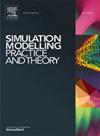Survey of CPU and memory simulators in computer architecture: A comprehensive analysis including compiler integration and emerging technology applications
IF 3.5
2区 计算机科学
Q2 COMPUTER SCIENCE, INTERDISCIPLINARY APPLICATIONS
引用次数: 0
Abstract
In computer architecture studies, simulators are crucial for design verification, reducing research and development time and ensuring the high accuracy of verification results. Several studies have developed and employed a verification environment by designing a custom in-house simulator that verifies the performance improvement of the proposed architecture for each research purpose by integrating multiple simulators or modifying existing ones. Recent advancements in deep neural networks and increased computational complexity have prompted research into emerging technologies, such as GPUs, processing-in-memory (PIM), and neural processing units (NPUs). Recently, custom in-house simulators were developed and actively employed for performance verification. However, constructing proper custom in-house simulators requires a greater grasp of the support functions and characteristics of current architectural simulators, which constitute the backbone of simulator creation. To meet these criteria, a comprehensive comparative analysis was conducted by examining the structures and output metrics supported across various architecture simulators, including representative CPU and memory simulators. Furthermore, it analyzes actual case studies of in-house simulators developed in recent emerging technology research ( i.e., GPUs, NPUs, PIM). Additionally, we examine the characteristics of compilers that support optimization for various recent workloads and simulators by analyzing case studies in which the integration of simulators and compilers has contributed to optimizing the overall simulator operations. Analyzing the overall verification process using these simulators, comparing each component, and confirming actual cases can provide essential insights for selecting and developing simulators suitable for computer architecture research. Consequently, this study contributes to maximizing the accuracy and efficiency of computer architecture research.
计算机体系结构中的 CPU 和内存模拟器调查:包括编译器集成和新兴技术应用在内的全面分析
在计算机体系结构研究中,模拟器对于设计验证、减少研发时间和确保验证结果的高精度至关重要。有几项研究通过设计定制的内部模拟器,开发并使用了验证环境,通过集成多个模拟器或修改现有模拟器,验证了针对每个研究目的提出的架构的性能改进。深度神经网络的最新进展和计算复杂性的增加促使人们对 GPU、内存处理(PIM)和神经处理单元(NPU)等新兴技术进行研究。最近,人们开发了定制的内部模拟器,并积极用于性能验证。然而,要构建合适的定制内部模拟器,需要进一步掌握当前架构模拟器的支持功能和特点,这些是创建模拟器的基础。为了满足这些标准,我们通过研究各种架构模拟器(包括具有代表性的 CPU 和内存模拟器)所支持的结构和输出指标,进行了全面的比较分析。此外,我们还分析了近期新兴技术研究(如 GPU、NPU、PIM)中开发的内部模拟器的实际案例研究。此外,我们还通过分析模拟器和编译器的集成有助于优化整个模拟器操作的案例研究,考察了支持针对各种最新工作负载和模拟器进行优化的编译器的特性。分析使用这些模拟器的整体验证过程、比较每个组件并确认实际案例,可为选择和开发适合计算机体系结构研究的模拟器提供重要启示。因此,本研究有助于最大限度地提高计算机体系结构研究的准确性和效率。
本文章由计算机程序翻译,如有差异,请以英文原文为准。
求助全文
约1分钟内获得全文
求助全文
来源期刊

Simulation Modelling Practice and Theory
工程技术-计算机:跨学科应用
CiteScore
9.80
自引率
4.80%
发文量
142
审稿时长
21 days
期刊介绍:
The journal Simulation Modelling Practice and Theory provides a forum for original, high-quality papers dealing with any aspect of systems simulation and modelling.
The journal aims at being a reference and a powerful tool to all those professionally active and/or interested in the methods and applications of simulation. Submitted papers will be peer reviewed and must significantly contribute to modelling and simulation in general or use modelling and simulation in application areas.
Paper submission is solicited on:
• theoretical aspects of modelling and simulation including formal modelling, model-checking, random number generators, sensitivity analysis, variance reduction techniques, experimental design, meta-modelling, methods and algorithms for validation and verification, selection and comparison procedures etc.;
• methodology and application of modelling and simulation in any area, including computer systems, networks, real-time and embedded systems, mobile and intelligent agents, manufacturing and transportation systems, management, engineering, biomedical engineering, economics, ecology and environment, education, transaction handling, etc.;
• simulation languages and environments including those, specific to distributed computing, grid computing, high performance computers or computer networks, etc.;
• distributed and real-time simulation, simulation interoperability;
• tools for high performance computing simulation, including dedicated architectures and parallel computing.
 求助内容:
求助内容: 应助结果提醒方式:
应助结果提醒方式:


